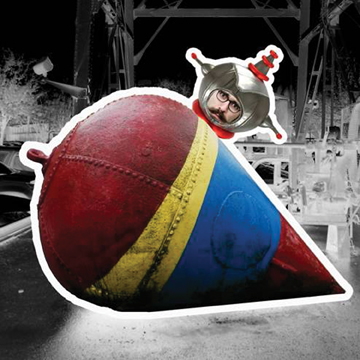Lost in Place: Not a Total Loss

Lost in Place is performed outdoors in a public setting and involves a lot of audience participation. The show is therefore partially improvisational and results will vary. In this instance the results were mostly just silly with the best moments being quite accidental. The best line of the evening was delivered by a person passing by who wasn’t aware of the context or asked to participate. Credit is due to the performers for taking on the challenge of an unpredictable venue and for successfully integrating the unexpected, but there just wasn’t enough of this element of surprise.
The participants were left to assemble themselves without instruction, and formed a crowd intimately huddled around the area of the opening scene. About ten feet away from this spontaneous huddle a man from another planet shyly initiates contact with the first fringe-going earthling that figures out what to do with the communication device that is tossed into the crowd.
This alien character asks questions about Earth and compares the answers with facts about his home planet “Arth”. Like their slant-rhyming names the two planets are not worlds apart--Arth is seems to be a foil for our human foibles. This other from another place has a clueless, nerdy quality and by positioning himself as the fool we experience our own sense of superiority, which will be gently mocked. For example, our values are challenged when we are congratulated for blocking out the view of the mountains with the monumental condominiums across the water, an achievement we owe to advanced technology such as the crane that constitutes the set for the skit.
This effect of promoting reflection through comic defamiliarization was vaguely promising but becomes far too silly to develop whatever might have been the intended themes. For example, the spaceman speaks of his “lady-husband”, a quirky twist with no apparent significance. Gender roles are not on the thematic menu. The oddity is just there to be cute, or at least the constant cuteness obscures the point.
More disjointed cuteness comes on the scene when we are introduced to a whale named Martha. Both the character and her costume are genuinely adorable. The costume reveals only the actress’ face and she does some good comedic acting with just her face but what any of this has to do with any larger story is only further confounded.
It really isn’t clear what, if anything, this show was trying to accomplish. Although the script is just too goofy, the acting and costumes do lend a some charm, as does the interaction with the audience and the venue. If you pull this “bring-your-own-venue” show out of a hat, I suggest you bring your own material too: creative participation that challenges the actors to improvise will highlight their strengths, and increased efforts to integrate surprises into their plans might also shed light on what those plans are.



